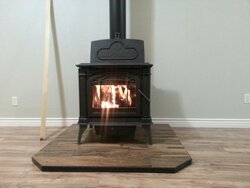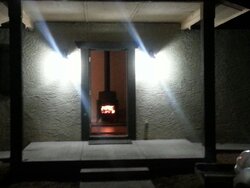Help me conceptualize what is happening throughout an overnight burn.
I understand with these EPA stoves, a hot fire is necessary to burn as much of the gases/particulate produced by a given firebox load of wood to maximize heat production and minimize environmental pollution. From what I can gather from the stove manual, my thermometer, and this forum, if the stove is operated at lower temps, then creosote production is a possibility. So, if I get the stovetop temp up to 400-600 and close down the damper about 30 minutes after the stove is lit (per stovetop thermometer readings) will I be producing creosote for whatever portion of the night my temps are lower than that magical ideal operating temp range?
In my mind I'm trying to plot out creosote production over an x, y graph with the y axis being temperature of stove (as a surrogate for creosote production) and the x axis being time. As the temperature rises, holds, and then decreases am I producing creosote during the rise and fall of temps? For example: If the stove is only above the bottom threshold of non-creosote production temperature for the time frame coinciding with 15 minutes after the fire is lit to 3 hours after damper is closed down, am I theoretically producing creosote from 0-15 minutes and from 3 hours to 11.75 hours?
This question is stemming from the fact that I still had red coals this morning 11.75 hours after I last loaded it with wood. The manual says max burns of 9 hours. Did I close the damper too much and produce creosote for much of the night?
(Stove is a Napoleon 1400C and wood is mostly Ponderosa Pine cut from dead/down trees with much of it being past its prime/punky. Wood is so dry that dust flies when hit with splitting maul. I don't want to give the Pine-Paranoia bunch any ammunition by burning my house down.)
I understand with these EPA stoves, a hot fire is necessary to burn as much of the gases/particulate produced by a given firebox load of wood to maximize heat production and minimize environmental pollution. From what I can gather from the stove manual, my thermometer, and this forum, if the stove is operated at lower temps, then creosote production is a possibility. So, if I get the stovetop temp up to 400-600 and close down the damper about 30 minutes after the stove is lit (per stovetop thermometer readings) will I be producing creosote for whatever portion of the night my temps are lower than that magical ideal operating temp range?
In my mind I'm trying to plot out creosote production over an x, y graph with the y axis being temperature of stove (as a surrogate for creosote production) and the x axis being time. As the temperature rises, holds, and then decreases am I producing creosote during the rise and fall of temps? For example: If the stove is only above the bottom threshold of non-creosote production temperature for the time frame coinciding with 15 minutes after the fire is lit to 3 hours after damper is closed down, am I theoretically producing creosote from 0-15 minutes and from 3 hours to 11.75 hours?
This question is stemming from the fact that I still had red coals this morning 11.75 hours after I last loaded it with wood. The manual says max burns of 9 hours. Did I close the damper too much and produce creosote for much of the night?
(Stove is a Napoleon 1400C and wood is mostly Ponderosa Pine cut from dead/down trees with much of it being past its prime/punky. Wood is so dry that dust flies when hit with splitting maul. I don't want to give the Pine-Paranoia bunch any ammunition by burning my house down.)





